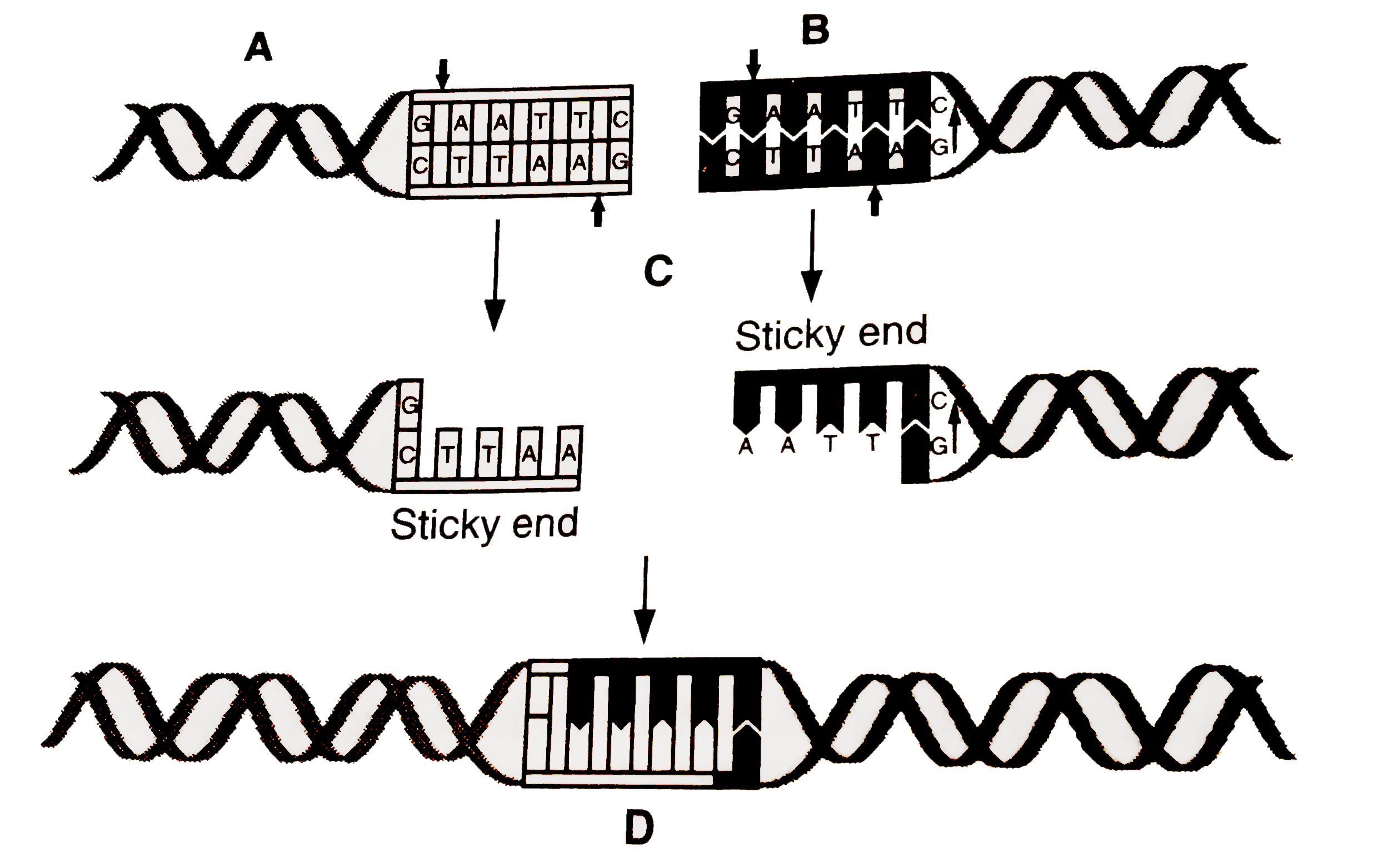Main steps in the formation of Recombinant DNA are given below.Arrange these steps in a correct sequence.
A.Insertion of recombinant DNA into the host cell.
B.cutting of DNA at specific location by restriction enzyme.
C.isolation of desired DNA fragment.
D.Amplification of gene of interest using PCR.
Choose the correct answer from the options given below:
C,A,B,D
C,B,D,A
B,D,A,C
B,C,D,A
To arrange the steps in the formation of recombinant DNA in the correct sequence, we need to analyze each step carefully:
1. Isolation of Desired DNA Fragment (C): The first step in the formation of recombinant DNA is to isolate the desired DNA fragment, which is often referred to as the gene of interest (GOI). This involves extracting the DNA from the source organism.
2. Cutting of DNA at Specific Location by Restriction Enzyme (B): After isolating the desired DNA fragment, the next step is to cut the DNA at specific locations using restriction enzymes. These enzymes recognize specific sequences in the DNA and create cuts, allowing us to obtain the gene of interest in a usable form.
3. Amplification of Gene of Interest Using PCR (D): Once we have the gene of interest, we need to make multiple copies of it. This is done using the Polymerase Chain Reaction (PCR), which amplifies the DNA, producing many copies of the gene of interest.
4. Insertion of Recombinant DNA into the Host Cell (A): Finally, the amplified gene of interest is inserted into a host cell. This host can be a bacterial cell, yeast, or any other suitable organism that can take up the recombinant DNA and express it.
Putting these steps together, the correct sequence is:
- C: Isolation of desired DNA fragment.
- B: Cutting of DNA at specific location by restriction enzyme.
- D: Amplification of gene of interest using PCR.
- A: Insertion of recombinant DNA into the host cell.
Thus, the correct order is C, B, D, A.
Final Answer: C B D A
- C: Isolation of desired DNA fragment.
- B: Cutting of DNA at specific location by restriction enzyme.
- D: Amplification of gene of interest using PCR.
- A: Insertion of recombinant DNA into the host cell.
Topper's Solved these Questions
Similar Questions
Amplification OF the Gene OF Interest using PCR|| Ligation OF the DNA fragment into a Vector|| Insertion OF Recombinant DNA into the Host cell/organism
View SolutionRestriction enzymes that are used in the construction of recombinant DNA are endonucleases which cut the DNA at specific recognition sequence? What would be the disadvantage if they do not cut the DNA at specific recogniion sequence?
View Solution
Knowledge Check
Diagrammatic representation of recombinant DNA technology is given below. Select the correct option:
 AA-Restriction endonuclease , B-Restriction endonuclease , C-DNA ligase , D-TransformationBA-Restriction endonuclease , B-Restriction exonuclease , C-DNA ligase , D-TranslocationCA-Restriction endonuclease , B- Restriction endonuclease, C-DNA polymerase, D-TranspositionDA-Restriction endonuclease B-Restriction exonuclease, C-DNA ligase , D-Transduction
AA-Restriction endonuclease , B-Restriction endonuclease , C-DNA ligase , D-TransformationBA-Restriction endonuclease , B-Restriction exonuclease , C-DNA ligase , D-TranslocationCA-Restriction endonuclease , B- Restriction endonuclease, C-DNA polymerase, D-TranspositionDA-Restriction endonuclease B-Restriction exonuclease, C-DNA ligase , D-TransductionThere are three basic steps in creating genetically modified organisms. Arrange these steps in the correct sequence.
(a.) Introduction of the identified DNA into the host
(b.) Maintenance of introduced DNA in the host and transfer of the DNA to its progeny
(c.) Identification of DNA with desirable genesAa → b → cBb → c → aCc → b → aDc → a → bSteps in formation of recombinant DNA by action of restriction endonuclease enzyme -Eco RI is given below. Identify A, B, C and D and select correct options :
 AA-vector DNA , B-Foreigh DNA, C-Eco RI, D-Recombinant DNABA-Foreign DNA , B-Vector DNA, C-Eco RI , D-Recombinant DNACA-Recombinant DNA, B-Foreigh DNA, C-Eco RI, D-Vector DNADA-Vector DNA , B-Eco Ri, C-Foreign DNA D-Recombinant DNA
AA-vector DNA , B-Foreigh DNA, C-Eco RI, D-Recombinant DNABA-Foreign DNA , B-Vector DNA, C-Eco RI , D-Recombinant DNACA-Recombinant DNA, B-Foreigh DNA, C-Eco RI, D-Vector DNADA-Vector DNA , B-Eco Ri, C-Foreign DNA D-Recombinant DNA
The flow chart given below represents the process of recombinant DNA technology. Identify A,B, C and D.

View SolutionThe different steps of recombinant DNA technology are given below randomly.
(i) Isolation of the DNA fragments or genes to be cloned
(ii) Introducting of the recombinant DNA into a suitable cell (usually E. coil) called host (transformation)
(iii) Multiplication/expression of the introduced gene in the host
(iv) Selection of the transformed host cells, and identification of the clone containing the desired gene/DNA fragment
(v) Insertion of the isolated gene in a suitable plasmid vector
Which of the following represents the correct sequences of steps ?
View SolutionThere are three basic steps in genetically modifying an organism. Arrange these steps in correct sequence
(a) Introduction of the identified DNA inot the host.
(b) Maintenance of introduced DNA in the host and transfer of the DNA to its progeny.
(c) Identification of DNA with desirable genes
View SolutionThe area of application of PCR include
A. productionn of monoclonal antibodies
B. insertion of recombinant DNA into organism
C. diagnosis of specific mutation
D. Detection of plant pathogens
View SolutionGiven below are four statements pertaining to separa- tion of DNA fragments using gel electrophoresis. Iden- tify the incorrect statements.
(a) DNA is negatively charged molecule and so it is loaded on gel towards the Anode terminal
(b) DNA fragments travel along the surface of the gel whose concentration does not affect movement of DNA.
(c) Smaller the size of DNA fragment larger is the dis- tance it travels through it.
(d) Pure DNA can be visualized directly by exposing UV radiation.
Choose correct answer from the options given below
View Solution